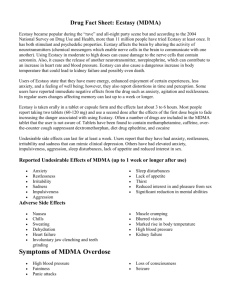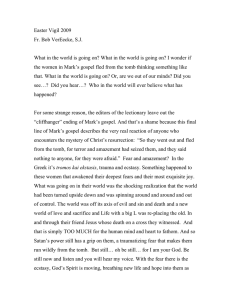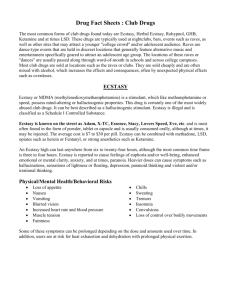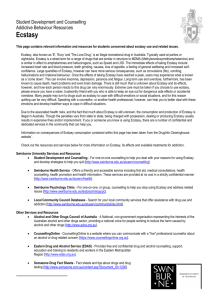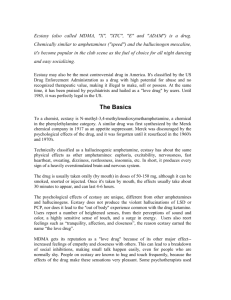Ecstasy: Anything But What the Name Implies
advertisement
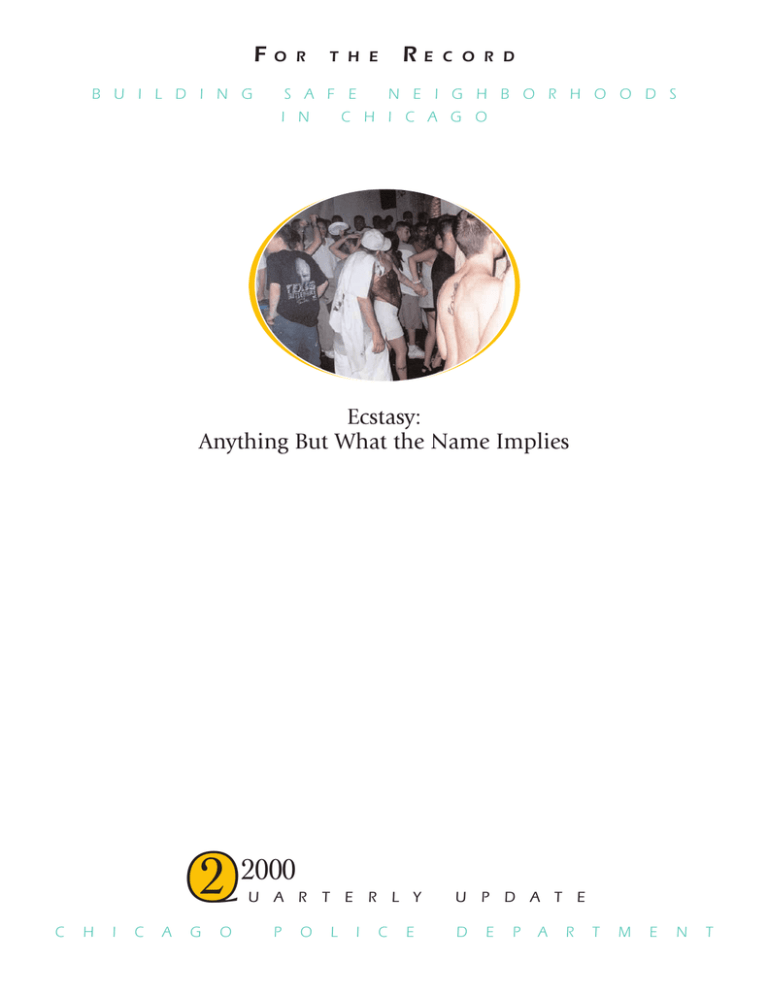
F B U I L D I N G O R R T H E E C O R D S A F E N E I G H B O R H O O D S I N C H I C A G O Ecstasy: Anything But What the Name Implies 2000 2 Q U C H I C A G O A R P O T E L R I C L Y U E D P E D P A T A E R T M E N T Ecstasy. An illegal drug combined with late night dances held at unsafe dance clubs is a recipe for danger for Chicago area youths. With your help we can repel its advance. Get the facts. Page 2. Incidents. Crime continues to decline. This DOWN edition of “For The Record” focuses on the location of these incidents. Page 8. DOWN Arrests. Arrests are down Citywide. Details begin on page 12. C H I C A G O P O L I C E D E P A R T M E N T • 2 0 0 0 TOGETHER WE MUST FIGHT THE RETURN OF ECSTASY drug that has been around for a long time is poised for a comeback in Chicago. The drug is Ecstasy, also know as XTC, X, Clarity and Essence. We are going to make sure this doesn’t happen. The Organized Crime Division has established an interdisciplinary team to target the users and organizers who have enabled the spread of this drug. These units will work in conjunction with the Strategic Inspections Task Force to shut down the locations where Ecstasy is used and sold. Our approach is already starting to work and the message is getting out— Ecstasy use will not be tolerated in the City of Chicago. The task force recently concluded a successful operation against Club Excel, an Ecstasy club on Chicago’s near West Side. We were able to aggressively go after the operators of this club thanks to a new provision of the Municipal Code of Chicago that makes arrests and prosecution more effective. However, we can not solve this problem alone. A The Chicago Police Department has teamed up with different city agencies to pass laws and institute a plan of action that will address the growing problems associated with the drug Ecstasy. Now we need your help. Let your children know about the dangers of this drug. If they are already using it, and you find out where, report that information to us so we can move against the dealers and operators. Communication and partnership between the police and the community is needed now more than ever to prevent tragedies such as the recent death of three young people in the suburbs who died as a result of ecstasy. In this issue of For the Record we have outlined many of the telltale signs associated with the use and sale of Ecstasy. Please take the time to familiarize yourself with the effects of this drug, so that if it reaches your neighborhood, you will be prepared to help us stop the spread of ecstasy. C H I C A G O P O L I C E D E P A R T M E N T • 2 0 0 0 Ecstasy: Anything But What the Name Implies What is Ecstasy? • Scientific name: Methylenedioxy-NMethamphetamine (MDMA) • Street names: Ecstasy, XTC, X, Adam, Clarity, Lover’s Speed, Essence • A synthetic, psychoactive (mind-altering) drug with hallucinogenic and amphetamine-like properties. • Called the “hug drug” because users experience feelings of serenity and calm, emotional closeness with those around, and heightened senses of touch and hearing. • Can be psychologically, but not physically, addictive. 2 C H I C A G O P O L I C E • Produced in the Netherlands, distribution controlled by Israeli organized crime. • Costs $0.50 per tablet to manufacture, sells for $25.00-$30.00 per tablet in Chicago. • Called a “club drug” because it is mostly found at rave parties/after-hours dance clubs. Users tend to be white, upperincome, suburban teenagers and young adults. • A “designer drug” which often has a high-end brand name, such as MercedesBenz, IBM, or Volkswagen, stamped upon it. D E P A R T M E N T • 2 0 0 0 Together We Must Fight the Return of Ecstasy Ecstasy: Gaining in Popularity Ecstasy is an illegal synthetic drug that was invented in 1912. Ecstasy, which acts both as a stimulant and a hallucinogen was first patented in Germany as an appetite suppressant. It was never legally manufactured for that or any other medical purpose. However, starting in the 1970s through the mid-1980s, Ecstasy was popular with some American psychotherapists as a drug to induce patients to confront difficult feelings. Despite the medical community’s rejection of ecstasy as a legitimate drug, it became a popular “designer drug” among recreational drug users. Due to the dangers of Ecstasy, the Federal Government enacted legislation in 1985 that made the sale, possession, or use of ecstasy illegal. Consequently, those still using ecstasy now use and purchase the drug through underground channels that are often difficult for the police to track. Recent information released by the National Institute for Drug Abuse suggests that the use of Ecstasy is rising at a significant rate. A recent national survey found that the number of 12th-graders who had used Ecstasy in their lifetime increased from 5.8 percent in 1998 to 8.0 percent in 1999. Local findings mirror this trend. According to the Illinois Youth Survey, Ecstasy use remained relatively stable in the early and mid-1990s, with approximately 2.5 percent lifetime use among high school students. Starting in 1997 the lifetime use among high school students rose to 4.2 percent. An ominous sign of things to come may be found in drug seizures. In 1998, the Chicago Police Department Narcotics Section seized 11 Ecstasy tablets. In 1999, the figure was 72,237. Ecstasy is a dangerous drug which is often used in dangerous circumstances. Because adolescents and young adults are the primary users, it is especially important for parents to be familiar with this drug and its effects. 1999 1998 In 1998, the Chicago Police Department Narcotics Section seized 11 Ecstasy tablets. In 1999, the figure was 72,237. C H I C A G O P O L I C E D E P A R T M E N T • 2 0 0 0 3 Ecstasy: Anything But What the Name Implies Ecstasy at Clubs and Raves Ecstasy is often sold and used at clubs and raves (large, all-night dance parties). Wicker Park and Bucktown are frequent locales for rave parties in Chicago. Clubs where Ecstasy is used are sometimes called "dry cabarets," "juice bars," or "teenage cabarets." Ecstasy use should be suspected at a club if the club: • is open at very late, unusual hours (e.g. 5 A.M.-11 A.M.). • sells no food or drink except for very expensive bottled water, often in the neighborhood of $7 per bottle. • is very crowded, well beyond what appears normal and safe for an establishment of its size. • has a separate room designated for cooling off, often requiring a fee to enter. The premises themselves may add to the risk of taking Ecstasy. To accommodate the large crowds associated with rave parties, the operators of venues may overload the electrical system with fans and other devices. This increases the chance of a fire, made all the more deadly by the crush of people inside. Patrons who overdose may encounter another premises-related risk. Instead of receiving medical attention, they are often removed from the immediate area of the party and placed in an alley. The operators of the clubs are reluctant to call for medical assistance, fearing police involvement. 4 C H I C A G O P O L I C E D E P A R T M E N T • 2 0 0 0 Together We Must Fight the Return of Ecstasy Ecstasy and PMA PMA (Paramethoxymethamphetamine) is a look-alike drug which is often sold as, or mistaken for, Ecstasy. Tablets from recent Chicago Police Department seizures have had the Mitsubishi corporate logo stamped on them. Like Ecstasy, PMA is a stimulant with hallucinogenic properties. However, PMA is a potentially lethal drug because a single tablet can increase the heart rate to dangerous levels, and drive up body temperature to the point that organs shut down. The danger is compounded by the fact that PMA takes two to three times as long to "kick in" as Ecstasy. Unsuspecting users who think they are taking Ecstasy when they are in fact taking PMA may take an additional dose when the drug does not "kick in" as soon as they expect. Three young people in the Chicago suburbs have recently died from taking PMA. They ranged from 17-20 years of age. In one case, the victim had taken a single PMA tablet. In another, the victim ingested five to seven tablets she believed to be Ecstasy. The body temperature of one of the victims was found to be 108 degrees Fahrenheit an hour after death. In addition to the dangers of illegal drug use, clubs where Ecstasy is used are oftentimes equally dangerous due to serious building and health code violations. C H I C A G O P O L I C E D E P A R T M E N T • 2 0 0 0 5 Ecstasy: Anything But What the Name Implies Ecstasy’s Physical Side Effects • • • • • • • • • • • • • Muscle tension Involuntary teeth clenching Nausea Blurred vision Rapid eye movement Chills/sweating Vomiting Increased heart rate High blood pressure Marked increase in body temperature Dehydration Stroke Damage to those parts of the brain which control thought and memory (with long-term use). Ecstasy’s Psychological Side Effects • • • • • • Ecstasy Use Clues There is also behavior of the guests which is typical of Ecstasy use. This includes: • conversation about "rolling," which means using Ecstasy. • substantial, mutual touching, resulting from the heightened sensory awareness Ecstasy produces. • use of "glow sticks," which heighten the hallucinogenic effects of the drug. • inhalation of Vicks Vapo-Rub, or application of Vicks Vapo-Rub around the nose area. This enhances the effects of the drug. • use of pacifiers, to combat the effects of involuntary teeth clenching. • profuse sweating. • excessive water consumption. Confusion Depression Sleep disturbance Drug craving Severe anxiety Paranoia These effects can occur weeks after taking the drug. 6 C H I C A G O P O L I C E D E P A R T M E N T • 2 0 0 0 Together We Must Fight the Return of Ecstasy The Chicago Police Response The Organized Crime Division has established an interdisciplinary team of officers from the Narcotics Section and the License Unit of the Vice Control Section. The Licensing Unit officers often complete a preliminary investigation where they look for many of the telltale signs associated with “Rave Clubs.” The licensing unit then turns over any useful information it obtains to the Narcotics Unit. It may also provide information to the Strategic Inspections Task Force, which can take direct action against the premises. Based on Licensing Unit information, officers from the Narcotics Unit will go undercover to infiltrate the club. “Our strategy is to go in and just become part of the crowd,” says Officer L. A. Nieves. “We take a low-key approach, and people start talking to us. After a while we know who the dealers are, and we make buys inside the club. That leads to arrests.” The interdisciplinary team recently concluded a successful operation against Club Excel, an Ecstasy club on Chicago’s Near West Side. This winning formula is now being replicated and other clubs that host rave parties are being targeted. Partnership With City Government Recent amendments to Section 4-156-300 of the Municipal Code of Chicago expands the liability for conducting a public amusement without a license—such as a rave party—to persons not previously specified in the ordinance. Liability now extends to the owner of the property, the lessee of the property, the manager of the property, the producer of the amusement, the presenter of the amusement, and the person conducting the amusement. Each person in violation of the subsection is subject to a fine of up to $10,000. This tool in the hands of the interdisciplinary team established by Superintendent Hillard is extremely effective. The owners of clubs hosting rave parties must now think twice before allowing illegal behavior to occur in their establishments. A further amendment creates a special class of public place of amusement license for premises to be used primarily by minors, where the amusement primarily involves music, music videos, and dancing. Premises so licensed may not operate between 2 A.M. and 11 A.M. which are primary hours for Ecstasy use. Violators of this law are subject to revocation of all city licenses pertaining to that establishment. Partnership With The Community The alarming rise in Ecstasy use is being addressed head on by the Chicago Police and City Government. While an effective interdisciplinary task force and stricter laws will help to reduce the incidence of ecstasy use, the Chicago Police still needs help from the community to stop this dangerous drug. If you have observed any of the behaviors outlined above, please contact the Narcotics Section of the Chicago Police Department at 1-800-CRACK44. Furthermore, if you believe rave parties exist in your neighborhood, share this information with your local beat officers and neighbors at your CAPS beat meeting. Through the CAPS problem-solving process, you can work with us to rid our community of the dangers of ecstasy. For information about your police beat and CAPS, please call 3-1-1. C H I C A G O P O L I C E D E P A R T M E N T • 2 0 0 0 7 Index Crimes — Q1- Q2 2000 Citywide Total: Down 6.8% 24 chicago o'hare international airport 16 20 not in city 17 25 Incidents 19 23 14 fullerton 18 120000 15 11 13 1 12 100000 60000 10 104,187 110,642 80000 16th 9 2 21 40000 8 DOWN 5.8% 20000 7 0 3 6 Q1-Q2 '99 Q1-Q2 '00 22 4 Q1-Q2 Index Crime Incidents 5 20000 15000 14,992 17,921 17,159 18,910 18,687 5000 16,518 10000 J F M A M J 0 8 C H I C A G O P O L I C E Percent change in reported total index crimes January-June 2000 compared to January-June 1999 D E P A R T M E N T DOWN –17.7 to –16.4 DOWN –13.2 to –10.6 DOWN –9.8 to –7.3 DOWN –5.6 to –2.5 UP +0.6 to +1.9 UP +2.8 to +5.9 • 2 0 0 0 Violent Index Crimes 24 Citywide: Down 4.4% chicago o'hare international airport 16 20 not in city NOTE: Violent Index Crime for this report includes Homicide, Agg. Assault/Battery, Robbery, and Criminal Sexual Assault. 17 25 19 23 14 fullerton 18 11 15 Q1-Q2 Violent Crime Incidents Incidents 5000 25000 4000 15000 2000 4,411 4,394 3,807 3,844 3,357 1 12 Percent change in reported violent index crimes January-June 2000 compared to January-June 1999 16th 10 9 2 21 8 7 3 6 DOWN –17.3 to –12.4 DOWN –11.9 to –6.5 10000 3,700 1000 23,513 3000 24,601 20000 13 5000 22 DOWN –5.7 to –1.5 DOWN 4.4% 4 UP +0.3 to +5.1 5 UP +8.7 to +9.3 0 0 J F M A M J Q1-Q2 '99 Q1-Q2 '00 UP +14.9 to 17.3 Property Index Crimes 24 chicago o'hare international airport Citywide: Down 6.2% 16 20 not in city NOTE: Property Index Crime for this report includes Burglary, Theft, Vehicular Theft, and Arson. 17 25 19 23 14 fullerton 18 11 15 Q1-Q2 Property Crime Incidents Incidents 15000 100000 12000 14,276 14,516 13,352 14,077 11,635 3000 12,818 6000 60000 80,674 9000 86,041 80000 1 12 Percent change in reported property index crimes January-June 2000 compared to January-June 1999 16th 10 9 8 2 21 7 3 6 DOWN –19.5 to –16.2 DOWN –14.9 to –11.1 40000 DOWN 20000 13 6.2% 22 DOWN –9.2 to –7.5 4 DOWN –5.6 to –2.4 5 DOWN –1.0 to –0.1 0 0 J F M A M C H I C A G O J Q1-Q2 '99 Q1-Q2 '00 P O L I C E UP +2.6 to +6.2 D E P A R T M E N T • 2 0 0 0 9 Focus On Location: Homicides Agg.Assaults/Batteries Citywide: Down 17.0% Citywide: Down 3.6% • 34.5% on street • 44.3% on street/sidewalk • 17.8% in automobile • 28.8% residential • 11.7% in apartment • 5.7% in alley 60 3000 350 50 15000 2500 300 12000 250 48 55 A M J 0 Q1-Q2 '99 Q1-Q2 '00 0 2,559 35 M 2,499 42 F 500 2,161 39 J 0 DOWN 17.0% 50 2,188 45 100 10 1,843 1000 1,840 150 20 J F M A M J DOWN 3000 3.6% 0 Q1-Q2 '99 Q1-Q2 '00 Robbery Incidents Criminal Sexual Assaults Citywide: Down 4.8% Citywide: Down 7.5% • 61% on street/sidewalk • 9.3% alley or parking lot • 6.7% residential • 54.1% residential • 13.9% alley or street • 6% non-commercial vehicle 250 2000 150 800 J 9,055 DOWN 4.8% J 0 Q1-Q2 '99 Q1-Q2 '00 C H I C A G O P O L I C E F M A M 600 205 206 164 186 164 100 4000 2000 0 1000 179 1,592 1,641 1,447 1,428 1,311 1,636 1000 9,508 6000 500 200 8000 1,104 1500 1,194 1200 10000 10 6000 13,090 9000 1500 13,581 264 200 30 2000 318 40 50 400 DOWN 200 0 J F M A D E P A R T M E N T M J • 7.5% 0 Q1-Q2 '99 Q1-Q2 '00 2 0 0 0 The second quarter for the record takes a specific look at where the index crimes are occurring, in addition to quarterly totals and trends. Burglary Incidents Theft Incidents Citywide: Down 2.6% Citywide: Down 9.2% • 76.5% residential • 28% on street • 2.4% small retail stores • 12.4% residential • 2% restaurants • 6.4% department stores • 6.3% parking lots 10000 3000 8000 50000 6000 40000 12000 500 J F M A M 0 Q1-Q2 '99 Q1-Q2 '00 J 8,904 8,888 8,141 2000 2.6% 8,602 3000 7,082 DOWN 0 30000 4000 6000 7,562 2,459 2,532 2,293 2,374 1,936 1000 2,343 1500 13,937 9000 14,310 2000 20000 DOWN 9.2% 10000 0 Q1-Q2 '99 Q1-Q2 '00 0 J F M A M J Vehicular Theft Incidents Arson Incidents Citywide: Up 0.5% Citywide: Down 12.3% • • • • • 36% residential • 10.4% alleys • 3.8% abandoned buildings 76.6% street 11.3% parking lot 2.2% alley 1.6% residence 3500 120 20000 800 100 700 500 500 0 J F M A M J C H I C A G O 0 Q1-Q2 '99 Q1-Q2 '00 P O L I C E 300 0 96 94 107 20 103 40 UP 0.5% 400 67 5000 60 75 2,176 2,352 2,325 2,346 1,905 2,381 1500 17,016 10000 16,934 2000 542 600 80 618 15000 27,887 2500 29,220 3000 1000 49,179 2500 54,179 60000 15000 200 DOWN 12.3% 100 J F M A D E P A R T M E N T M J • 0 Q1-Q2 '99 Q1-Q2 '00 2 0 0 0 11 Total Index Crime Arrests Q1-Q2 Index Crime Arrests Arrests 6000 30000 5000 4000 20000 3000 5,011 4,427 5,003 4,771 1000 4,318 2000 4,607 15000 J F M A M J 10000 DOWN 2.4% 5000 0 Q1-Q2 '99 Q1-Q2 '00 0 Violent Index Crime Arrests 28,137 25000 28,816 Citywide: Down 2.4% Q1-Q2 Violent Crime Arrests Arrests 1200 8000 1000 5000 600 3000 1,096 1,164 1,021 1,130 200 958 400 1,003 4000 DOWN 2000 6.4% 1000 0 0 J F M A M J Q1-Q2 '99 Q1-Q2 '00 Q1-Q2 Property Crime Arrests Property Index Crime Arrests 6,372 6000 800 6,809 Citywide: Down 6.4% 7000 Arrests 4000 25000 3500 3000 15000 3,881 3,406 3,839 3,675 1000 3,315 1500 3,649 2000 J F M A M J 21,765 2500 22,007 Citywide: Down 1.1% 20000 10000 DOWN 5000 1.1% 500 0 0 12 C H I C A G O P O L I C E D E P A R T M E N T Q1-Q2 '99 Q1-Q2 '00 • 2 0 0 0 Agg.Assault/Battery Arrests Homicide Arrests Citywide: Down 6.9% Citywide: Down 19.5% 60 800 400 700 300 600 150 A M 0 Q1-Q2 '99 Q1-Q2 '00 J 669 M F 745 J 100 640 19.5% 738 200 596 DOWN 50 0 2000 300 100 58 46 43 60 10 50 53 20 3000 400 3,943 200 555 30 4000 500 4,236 250 385 40 5000 350 310 50 J F M A M J 0 DOWN 1000 6.9% 0 Q1-Q2 '99 Q1-Q2 '00 Sexual Assault Arrests Robbery Arrests Citywide: Down 3.8% Citywide: yDown 3.0% 80 350 400 2000 70 300 350 60 A M J 0 Q1-Q2 '99 Q1-Q2 '00 Burglary Arrests 61 308 0 100 10 62 311 M 3.0% 50 150 20 68 270 F Down 200 30 55 277 J 500 250 40 71 286 100 284 150 50 66 1000 1,736 1,790 200 383 300 1500 398 250 J F M A M J DOWN 3.8% 50 0 Q1-Q2 '99 Q1-Q2 '00 0 Theft Arrests Citywide: Up 4.6% Citywide: Down 2.0% 2500 500 15000 2500 2000 400 374 419 M J 0 Q1-Q2 '99 Q1-Q2 '00 0 Vehicular Theft Arrests 2,253 394 A 500 2,421 376 M 4.6% 2,073 341 F 500 2,370 356 J UP 2,010 J F M A M J 6000 DOWN 0 Q1-Q2 '99 Q1-Q2 '00 Arson Arrests Citywide: Up 22.1% 35 1200 150 8000 30 1000 7000 M A M J 0 Q1-Q2 '99 Q1-Q2 '00 C H I C A G O P O L I C E 0 26 F 5 11 1.5% 10 34 DOWN 26 2000 27 977 1,033 905 1,109 937 1,066 60 3000 1000 J 90 15 138 20 4000 113 5000 120 14 0 25 6,027 600 6000 6,117 800 200 2.0% 3000 0 Citywide: Down 1.5% 400 13,340 2,260 1000 1000 100 9000 2,213 200 2,160 1500 1500 13,617 12000 2000 300 J F M A M J D E P A R T M E N T UP 30 22.1% 0 Q1-Q2 '99 Q1-Q2 '00 • 2 0 0 0 13 For The Record: Building Safe Neighborhoods is produced by the Research and Development Division of the Chicago Police Department. For more information contact: Research and Development Division Chicago Police Department 3510 South Michigan Avenue Room 4001 Chicago, IL 60653 (312) 745-6071 (312) 745-6932 (fax) police@ci.chi.il.us www.ci.chi.il.us/CAPS
